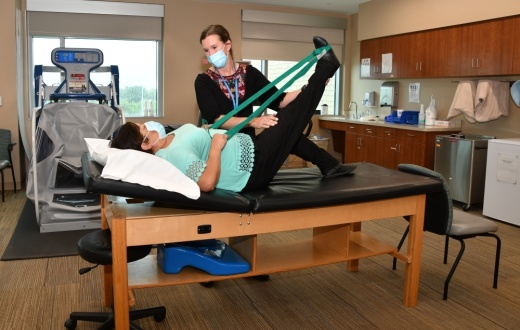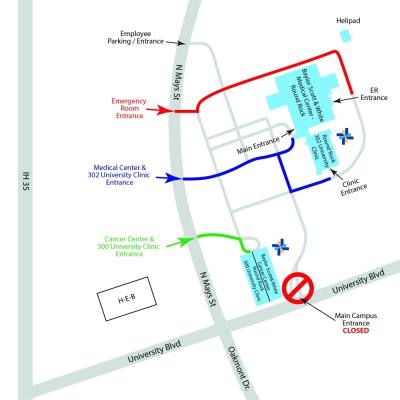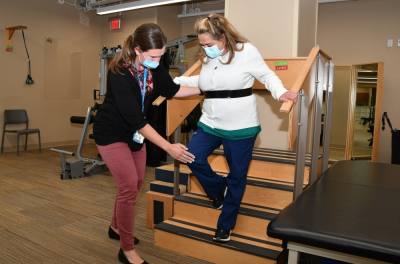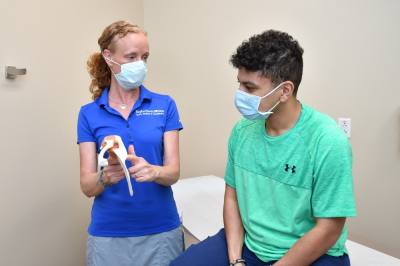Got a sprain, strain or other sports-related injury? If so, and you find yourself at Baylor Scott & White Medical Center – Round Rock this year, plan some extra time for your check-up.
That’s because the main entrance on University Boulevard is closed as the City of Round Rock continues a roadway expansion project in the area. Three other building entrances are available from North Mays Street, however. Just follow the signs to get where you need to go.
But don’t let a little construction put a detour on your bone and joint care. Rest assured that Baylor Scott & White Medical Center – Round Rock is ready and eager to serve Central Texans who need orthopedic care. The team commonly treats concerns of the shoulders (like rotator cuff injuries from golf) or knees (like ACL tears from football). They also take care of other complaints in the hands, wrists, hips, ankles, feet, elbows and spine.
The board-certified, fellowship-trained physicians on the medical staff at Baylor Scott & White - Round Rock care for patients of all ages for all kinds of sports-related injuries—whether that is an individualized activity like running or yoga, or team events like tennis or basketball.
Even so, prevention is still the best medicine. As the weather warms up and folks get back out there (with COVID-19 precautions), the Baylor Scott & White - Round Rock care team has a few tips to share about injury prevention from head to toe:
1. Give your body a chance to warm up.
Before you start any activity, always take time to stretch, suggests Mark Billante, MD, an orthopedic surgeon on the medical staff at Baylor Scott & White Medical Center – Round Rock.
“Most people don’t stretch before an athletic activity, or even warm up for that matter,” he said. “Whatever you’re doing, we recommend stretching or warming up the body part that will be used the most.”
Warm-up routines can vary with the activity, Dr. Billante added. Running? Stretch your legs. Baseball? Warm up your core and arms. Birdwatching? Do wrist rotations. Whatever it is, aim to get your body ready for action.
“By warming up, you’re helping to bring blood flow into that area of the body you’re activating,” he said. “You’re also stretching out the muscles and tendons, which helps make them more supple and less prone to injury, as we see with hamstring pulls or similar problems. This also relieves strain on nearby joints. All of this is a win-win-win for your body.”
2. Gradually work your way up.
Even with a proper warm-up, don’t go full speed right away. Instead, work your way up to the activity by taking it slow at first and gradually increasing intensity as you feel ready.
While there is no hard and fast rule on the right pace to set for yourself, try not to go too fast too quickly. Working your way up has two important advantages: For one, it can help your bones and muscles adjust to the physical demands of the exercise. It can also help you get in the right headspace for it, which can support mental endurance.
3. Switch up your activities.
You should consider changing up your activities instead of repeating the same workout or sport every time. Doing so can not only switch things up for boredom’s sake, but it can also have some physical benefits.
“Injuries are often due to overuse, meaning when you strain the same area of the body repeatedly over time,” said Heather Fullerton, MD, physical medicine and rehabilitation physician on the medical staff at Baylor Scott & White Medical Center – Round Rock. “It’s certainly a good idea to change up your routines when you can—such as alternating different strength exercises like weightlifting or squats with different aerobic exercises like running or swimming.”
4. Know when to see the doctor.
Some people tend to chalk up aches and pains to getting older—as if it’s just a normal part of aging. But Dr. Fullerton cautions that if you have discomfort that lasts every time you run, do yoga or engage in any other activity, it might be time to see a doctor.
“See someone if you’re experiencing any pain or limitations in mobility that interfere with activities you do or would like to do,” she said. “There are several treatment options that can work for a variety of orthopedic problems across all ages. Your physician can do a physical exam to determine the issue and develop a care plan from there.”
Regardless of age, you don’t have to live with pain or limited mobility to participate in physical activities. Call for an appointment with one of the board-certified, fellowship-trained sports medicine physicians on the medical staff at Baylor Scott & White Medical Center – Round Rock to get your body back on track for whatever this season brings.
And as you get back out there and enjoy this fresh Texas air, remember to stay safe and remain vigilant about COVID-19. From social distancing to wearing facemasks, even small precautions can make a big difference.
For more information about Baylor Scott & White – Round Rock programs, or to download turn-by-turn directions for alternate travel routes to the campus during construction, visit: bswhealth.com/locations/round-rock/construction-updates
Physicians provide clinical services as members of the medical staff at one of Baylor Scott & White Health’s subsidiary, community or affiliated medical centers and do not provide clinical services as employees or agents of those medical centers or Baylor Scott & White Health.
Select your community
Support Us
News
- Austin Metro
-
Houston Metro
- Houston Metro Home
- Bay Area
- Bellaire | Meyerland | West University
- Conroe | Montgomery
- Cy-Fair | Jersey Village
- Cypress
- Heights | River Oaks | Montrose
- Katy | Fulshear
- Lake Houston | Humble | Kingwood
- New Caney | Porter
- Pearland | Friendswood | Manvel
- Spring | Klein
- Sugar Land | Missouri City
- The Woodlands
- Tomball | Magnolia
- Dallas | Fort Worth Metro
- San Antonio Metro









